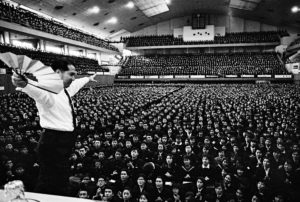Deeply committed to the education and development of children and youth, SGI President Ikeda, as the third Soka Gakkai president, established the high school division in June 1964, the junior high school division in January 1965, and the boys and girls division in September 1965—which together comprise the Future Division.
The present generation of future division members will be the key protagonists of the kosen-rufu movement when the Soka Gakkai celebrates its 100th anniversary in 2030. With this recognition, the Soka Gakkai monthly study journal Daibyakurenge (starting from its November 2010 issue) has launched a series chronicling President Ikeda’s efforts to foster the future division members, along with graduates’ personal accounts and recollections of meetings and interactions with President Ikeda in their youth.

The meeting came to an end at 7:20 p.m. President Ikeda was about to leave the room when he took the microphone again and said: “I would like to know your wishes. We’ll distribute some paper, so please write your hopes and dreams on it.”
President Ikeda never stopped thinking about the young phoenixes to whom he was entrusting the future of the Soka Gakkai.
Michiko Ishii (Soka Gakkai Business Professionals Division vice national leader): I felt the weight of the expectations that President Ikeda had for the high school division. My grades were poor, and I didn’t think I had any special talents. I couldn’t imagine how I could live up to his hopes for us.
I was one of the event staff stationed at the very front of the hall, near the stage. Wanting to ask President Ikeda about my concerns, I called out to him as he was leaving the hall.
He looked at me and said: “Don’t worry all by yourself. Don’t let your worries make you doubt your abilities. Find someone you look up to in faith whom you can talk to.”
He spoke as if he knew what I was about to say. I was astonished.
I wrote on the sheet of memo paper passed out to us, “I wanted to ask you about good fortune and mission,” and handed it in.
A few days later I received a piece of calligraphy from President Ikeda that read, “Become happy.” When I saw it, I felt courage well up from within. Thanks to President Ikeda, I was able to understand my mission, my purpose in life.
■ ■ ■
The high school division members who attended that meeting came to be known as the Five Year Group, subsequently getting together every five years.
President Ikeda writes:
Five years later, during the New Year of 1971, we met again at Mount Fuji. The young phoenixes had grown up considerably. I praised my loyal friends and named them the Five Year Group, promising to continue to meet with them every five years. I also sent them a celebratory poem:
Just watch
after five years
how great the trees will have grown.[1]Masato Enomoto (Soka Gakkai vice ward leader): At the Five Year Group general meeting of 1975, President Ikeda told me, “As a member of the Five Year Group, please do your absolute best to support the Soka Gakkai.”
Then he said to everyone: “The Soka Gakkai was built through the mentor-disciple bond between the first, second and third presidents. The mentor-disciple relationship is very important. You are my successors. You will put the finishing touches on the foundation of kosen-rufu.”
After President Ikeda was forced to step down as Soka Gakkai president in 1979 due to the collusion of the priesthood and people who had betrayed the Soka Gakkai, he was prevented from speaking at meetings and no longer appeared in the Seikyo Shimbun.
On February 10, 1980, the fourth Five Year Group general meeting was held, just as President Ikeda had promised. Three thousand members gathered together in the Toda Memorial Auditorium in Tokyo.
Knowing how much we wanted to see him, President Ikeda attended, even though he had been forced to step down as president. He declared: “Live your entire life with the Soka Gakkai. Let’s advance courageously into the harsh north wind.”
As he made his way out of the auditorium, walking among the participants, he addressed each person. He even sat for a commemorative photo with the event staff members who worked so hard behind the scenes to make the meeting a success.
President Ikeda launched his counter-offensive against the tyranny of the priesthood from this Five Year Group meeting.
■ ■ ■
The day after the original high school division meeting, held at the Grand Reception Hall, photographs of the high school division, junior high school division and boys and girls division members, as well as an article about the tree-planting ceremony, were featured on the front page of the January 4 issue of the Seikyo Shimbun.
In the center of the lower column of the paper was an article with the headline, “High School Division Meeting Time Changed.” It said: “The starting time of the January high school division meeting for the Tokyo metropolitan area has been changed. It had been announced as starting at 10 a.m. on January 6 (Thursday), but for scheduling reasons the starting time has been changed to 1 p.m. on the same date.”
Masaichi Ueda (Soka Gakkai senior advisor; former national high school division leader and national young men’s division leader): President Ikeda suggested holding the January high school division meeting for the Tokyo metropolitan area in the afternoon.
Realizing that the afternoon would indeed be more convenient for members coming from outlying Kanto areas, the high school division planning committee decided to make the change. That change was promptly reported in the Seikyo Shimbun. To make sure that no one missed the new information, we divided up the members among ourselves and contacted everyone.
I was certain that this meant that President Ikeda would be attending. And in fact, that is exactly what happened.
The year 1966 really began as the year of the high school division.
■ ■ ■
On January 6, the January high school division meeting for the Tokyo metropolitan area took place at the Taito Ward Gymnasium. It was only three days after the national high school division meeting.
Though the meeting didn’t start until the afternoon, high school division members had been steadily arriving from the morning. Groups of high school division members could be seen hurrying down the road adjacent to the Sumida River that led from nearby Asakusa Station, their breath condensing in white puffs in the cold winter air.
By just after 11 a.m. the gymnasium was already filled. High school corps leaders went up on the stage of their own accord to lead members in Soka Gakkai songs.
When President Ikeda appeared at a little past 12:30 p.m., thunderous applause rocked the auditorium. After members presented experiences and leaders offered remarks, President Ikeda stood up to speak. “I am delighted to see you all looking so well and energetic,” he said.
His opening words were filled with compassion. He continued with fervor:
Up to today, youth division graduates were the backbone of the Soka Gakkai providing its forward momentum. Graduates of the student division in turn have served as the backbone and impetus of the youth division. From now on, it will be the graduates of the high school division who will secure the foundation of kosen-rufu in the future. Please do your best!
I have fought very hard up to now, opening the way. Now is the time to focus my attention on fostering the next generation. Having raised and solidified the youth and student divisions, now it is time for the high school division. I hope you understand my sentiments.
Haruo Nakagome (Soka Gakkai vice chapter leader): I never imagined I would have another opportunity to see President Ikeda just three days after the national high school division meeting.
President Ikeda instilled the mentor-disciple spirit, the pillar of faith in the Daishonin’s Buddhism, on the pure white canvas of the high school division members’ hearts. It would stay with us throughout our lives.

Soka Gakkai President Ikeda leads “Song of the New Century” at the high school division meeting for the Tokyo Metropolitan area, held in the Taito Gymnasium in Tokyo, January 6,1966. Photo by Seikyo Press.
■ ■ ■
At the meeting, President Ikeda spoke to the young phoenixes about the “Korean Joan of Arc,” Yu Kwan Sun (1902–20).
Seikou Itabashi (Soka Gakkai prefecture executive leader): President Ikeda talked to us about Yu Kwan Sun, who died in prison at the age of 17. Opposing Japan’s cruel colonial rule over Korea, she was tortured by Japanese police officials, but continued to declare to the very end that she would gladly die for Korean independence. This, President Ikeda told us, was an example of a person who remained true to her beliefs to the very end.
After his speech, he said: “All it takes is a single individual who upholds his or her commitment to the very end. That person is a true disciple, united with his or her mentor.” President Ikeda hoped and waited for the appearance of such genuine disciples who would uphold faith throughout their lives.
■ ■ ■
President Ikeda continued to speak with conviction: “If people with this spirit of Yu Kwan Sun appear within the high school division, the student division and the Soka Gakkai as a whole, our movement will be strong. The time is here. I am certain such people exist.”
Chikako Higure (Soka Gakkai women’s division vice headquarters leader): My family began practicing Nichiren Buddhism to overcome such difficulties as financial hardship, my mother’s illness and my father’s drunken rages. Having grown up in such circumstances, I had a rather introverted personality, and I was still very timid when I became a high school division corps leader. But hearing President Ikeda say those words, I decided that I needed to forge myself into a person with a strong revolutionary spirit like Yu Kwan Sun.
President Ikeda also said, “I don’t want anyone in the Soka Gakkai to undergo a painful struggle like that of Yu Kwan Sun; I’ll take all the suffering on myself.”
I was determined at that moment to dedicate my life to the great struggle for kosen-rufu alongside President Ikeda.
Shogo Ohashi (Soka Gakkai Writers Division advisor; vice ward leader): It was a turbulent era. The previous year (1965), the war in Vietnam intensified with the U.S. bombings of the north. Pollution was a severe problem within Japan. My friends and I wondered what we could do to build a peaceful world. We were searching for how to live our lives.
It was amid these troubled times, as I was thinking about the correct way to live, that I heard President Ikeda’s guidance. He was telling us that the only way to carry out the difficult task of kosen-rufu was to pull ourselves up from where we were and press forward.
It is critical to further expand the base for kosen-rufu and ensure the eternal development of the Soka Gakkai. The key to achieving this is one thing only: transmitting faith in Nichiren Buddhism to our successors.
■ ■ ■
Speaking of Yu Kwan Sun, President Ikeda said: “This teenaged girl, without the Gohonzon, without anything, fought based on her determination to save her country. Today she is looked up to as a national hero who gave her life for her country, and songs are sung about her.”
Kosaku Eto (Soka Gakkai vice president): How does one fight, like Yu Kwan Sun, for the happiness of the people and world peace? President Ikeda showed us how through his own example.
I accompanied President Ikeda on his third visit to the Soviet Union, in May 1981, to meet with Soviet Premier Nikolai Tikhonov (1905–97). At that time, the Soviet Union was viewed by the rest of the world as a cold, dark and frightening communist empire, and no one wanted to engage with it.
The morning after his meeting with the premier, President Ikeda did gongyo in his lodgings with those traveling with him. On that occasion, he remarked:
They say that northern countries have no affinity for Buddhism, but that only applies to Shakyamuni’s Buddhism. Nichiren Daishonin inscribed the Gohonzon so that everyone in the world could become happy.
That is why I’m certain that Bodhisattvas of the Earth will also emerge here in Russia. It will take time, however. The right time is very important. We need to create the time. Wheat doesn’t germinate and grow in an eternally frozen wasteland. With our daimoku, let’s melt the ice and snow, and cultivate this land!
His words resounded powerfully. After gongyo, he said: “No matter how high the wall standing before you rises, know that things are constantly changing. The only unchanging thing in the universe is Nam-myoho-renge-kyo. No matter how tough the situation may seem, it will definitely change.”
At that time, no one imagined the Soviet system would change. But President Ikeda was convinced that the day would come when the flower of the Mystic Law would bloom there.
President Ikeda proposed to Premier Tikhonov: “People around the world are worried about the tensions between the United States and the Soviet Union. I hope that U.S. and Soviet leaders will meet as soon as possible for direct talks—not in Moscow or Washington, D.C., but perhaps in a third country, like Switzerland.”
President Ikeda continued after that to engage with Soviet leaders on numerous occasions. And, just as he had suggested, eventually Mikhail Gorbachev, then Soviet Communist Party general secretary, met
with former U.S. President Ronald Reagan (1911–2004) in Switzerland (in 1985).Following that, the USSR was reborn as the new Russia, and freedom of religion was recognized. Bodhisattvas of the Earth emerged, and now there is an SGI headquarters in Russia.
I will never forget what President Ikeda said: “I’m not afraid of anything. I’m not a politician or a businessman. I’m a representative of ordinary citizens. I have 10 million Soka Gakkai members behind me.”
President Ikeda is truly a pioneer of world peace.
At the time of the 80th anniversary of the Soka Gakkai’s founding, President Ikeda had received 300 academic awards and honors. For the sake of his successors following after him, he continues to open the way for global kosen-rufu.
■ ■ ■
President Ikeda has said: “It is critical to further expand the base for kosen-rufu and ensure the eternal development of the Soka Gakkai. The key to achieving this is one thing only: transmitting faith in Nichiren Buddhism to our successors.”
He has also said: “There is always a time when one person’s work reaches its culmination. What matters then is who stands up to carry it forward.”
President Ikeda has the highest expectations for the appearance of true disciples who will carry on the lineage of Soka mentors and disciples.
Two days after the Tokyo metropolitan area high school division meeting, President Ikeda began his lecture series on Nichiren’s writings for the high school division. The first lecture was on “The True Aspect of All Phenomena,” which illuminates the mission of disciples, the Bodhisattvas of the Earth.
The curtain thus rose on a period of genuine training that would ensure the eternal development of the Soka Gakkai’s movement.
To be continued in an upcoming issue.
Translated from the January 2011 issue of the Daibyakurenge, the Soka Gakkai’s monthly study journal.
References
- From “Thoughts on The New Human Revolution,” no. 190, which appeared in the January 15, 2001, issue of the Seikyo Shimbun. ↩︎
You are reading {{ meterCount }} of {{ meterMax }} free premium articles

